Design and Measurement of a High-Efficiency W-Band Microstrip Antenna with Enhanced Matching for 6G Automotive Radar and ADAS Systems
Abstract
1. Introduction
1.1. Background and Motivation
1.2. Application Scope and Specifications
2. The Proposed ADAS Antenna Design
2.1. Tapered Transition Design
2.2. Impact of Short Pins on Antenna Performance and Design
3. Results and Discussion
4. Thermal Impact on Antenna Geometry and Resonance in ADAS Applications
5. Integration and Simulation of the Proposed Antenna in ADAS-Enabled Environments
5.1. Initial Evaluation of Vehicle-Mounted Antenna in ADAS
5.2. Virtual Scenario for Smart Road Deployment
5.3. Impact of Non-Embedded Antennas on Smart Road Performance
6. Conclusions
Author Contributions
Funding
Institutional Review Board Statement
Informed Consent Statement
Data Availability Statement
Acknowledgments
Conflicts of Interest
References
- Boban, M.; Kousaridas, A.; Manolakis, K.; Eichinger, J.; Xu, W. Connected Roads of the Future: Use Cases, Requirements, and Design Considerations for Vehicle-to-Everything Communications. IEEE Veh. Technol. Mag. 2018, 13, 110–123. [Google Scholar] [CrossRef]
- Sadaf, M.; Iqbal, Z.; Javed, A.R.; Saba, I.; Krichen, M.; Majeed, S.; Raza, A. Connected and Automated Vehicles: Infrastructure, Applications, Security, Critical Challenges, and Future Aspects. Technologies 2023, 11, 117. [Google Scholar] [CrossRef]
- Dey, K.C.; Yan, L.; Wang, X.; Wang, Y.; Shen, H.; Chowdhury, M.; Yu, L.; Qiu, C.; Soundararaj, V. A Review of Communication, Driver Characteristics, and Controls Aspects of Cooperative Adaptive Cruise Control (CACC). IEEE Trans. Intell. Transport. Syst. 2016, 17, 491–509. [Google Scholar] [CrossRef]
- National Safety Council. Available online: https://www.nsc.org/?srsltid=AfmBOoo7_Gti24ezHf8cWurD8fIpa6R_vGLYJ9-EbyV12Jj-10_rt9K (accessed on 15 November 2025).
- Wang, H.; Feng, Y.; Tian, Y.; Wang, Z.; Hu, J.; Tomizuka, M. Towards the Next Level of Vehicle Automation Through Cooperative Driving: A Roadmap from Planning and Control Perspective. IEEE Trans. Intell. Veh. 2024, 9, 4335–4347. [Google Scholar] [CrossRef]
- ISO 26262:2024; Road Vehicles Functional Safety. International Organization for Standardization (ISO): Geneva, Switzerland, 2024.
- Shaikh, F. Advance Driver Assistance Systems (ADAS); Technical Report; Technische Universität Chemnitz: Chemnitz, Germany, 2024. [Google Scholar] [CrossRef]
- Bathla, G.; Bhadane, K.; Singh, R.K.; Kumar, R.; Aluvalu, R.; Krishnamurthi, R.; Kumar, A.; Thakur, R.N.; Basheer, S. Autonomous Vehicles and Intelligent Automation: Applications, Challenges, and Opportunities. Mob. Inf. Syst. 2022, 2022, 7632892. [Google Scholar] [CrossRef]
- Sayem, N.M.; Baki, A.K.M.; Faysal, F.; Mahmud, S.T.; Jubayer, A.; Rifat, T.A. Development of Novel and High Gain Microstrip Patch Antennas at Different Frequency Bands for 6g Applications. PIER C 2023, 137, 263–275. [Google Scholar] [CrossRef]
- Nagy, L. Microstrip Antenna Development for Radar Sensor. Sensors 2023, 23, 909. [Google Scholar] [CrossRef]
- Islam, Z.U.; Bermak, A.; Wang, B. A Review of Microstrip Patch Antenna-Based Passive Sensors. Sensors 2024, 24, 6355. [Google Scholar] [CrossRef]
- Zhu, J.; Liu, J. Design of Microstrip Antenna Integrating 24 GHz and 77 GHz Compact High-Gain Arrays. Sensors 2025, 25, 481. [Google Scholar] [CrossRef]
- Bu, D.; Qu, S. Magneto-electric Dipole Antenna Array for 77 GHz Automotive Radar. IET Microw. Antenna Amp. Prop. 2024, 18, 96–105. [Google Scholar] [CrossRef]
- Yeap, S.B.; Qing, X.; Chen, Z.N. 77-GHz Dual-Layer Transmit-Array for Automotive Radar Applications. IEEE Trans. Antennas Propag. 2015, 63, 2833–2837. [Google Scholar] [CrossRef]
- Su, G.-R.; Li, E.S.; Kuo, T.-W.; Jin, H.; Chiang, Y.-C.; Chin, K.-S. 79-GHz Wide-Beam Microstrip Patch Antenna and Antenna Array for Millimeter-Wave Applications. IEEE Access 2020, 8, 200823–200833. [Google Scholar] [CrossRef]
- Zang, Z.; Zaman, A.U.; Yang, J. Single-Layer Dual-Circularly Polarized Series-Fed Gap Waveguide-Based Slot Array for a 77 GHz Automotive Radar. IEEE Trans. Antennas Propag. 2023, 71, 3775–3784. [Google Scholar] [CrossRef]
- Zubair, M.; Jabbar, A.; Tahir, F.A.; Kazim, J.U.R.; Rehman, M.U.; Imran, M.; Liu, B.; Abbasi, Q.H. A High-Performance Sub-THz Planar Antenna Array for THz Sensing and Imaging Applications. Sci. Rep. 2024, 14, 17030. [Google Scholar] [CrossRef] [PubMed]
- Li, Y.; Ma, H.; Peng, H.; Liu, H. W-Band Microstrip Antenna Arrays on Glass. Electronics 2025, 14, 2133. [Google Scholar] [CrossRef]
- Teng, L.; Yu, Z.; Zhu, D.; Hao, C.; Jiang, N. Antenna Array Design Based on Low-Temperature Co-Fired Ceramics. Micromachines 2024, 15, 669. [Google Scholar] [CrossRef] [PubMed]
- Lan, S.; Huang, C.; Wang, Z.; Liang, H.; Su, W.; Zhu, Q. Design Automation for Intelligent Automotive Systems. In Proceedings of the 2018 IEEE International Test Conference (ITC), Phoenix, AZ, USA, 29 October–1 November 2018; IEEE: New York, NY, USA, 2019; pp. 1–10. [Google Scholar]
- Pimentel, J. Rigorous Safety Analysis and Design of ADAS and ADS: Implications on Tools. arXiv 2024, arXiv:2406.08350. [Google Scholar] [CrossRef]
- Noor-A-Rahim, M.; Liu, Z.; Lee, H.; Khyam, M.O.; He, J.; Pesch, D.; Moessner, K.; Saad, W.; Poor, H.V. 6G for Vehicle-to-Everything (V2X) Communications: Enabling Technologies, Challenges, and Opportunities. Proc. IEEE 2022, 110, 712–734. [Google Scholar] [CrossRef]
- Mehta, A.A.; Padaria, A.A.; Bavisi, D.J.; Ukani, V.; Thakkar, P.; Geddam, R.; Kotecha, K.; Abraham, A. Securing the Future: A Comprehensive Review of Security Challenges and Solutions in Advanced Driver Assistance Systems. IEEE Access 2024, 12, 643–678. [Google Scholar] [CrossRef]
- Greco, F.; Arnieri, E.; Amendola, G.; De Marco, R.; Boccia, L. A 77 GHz Transmit Array for In-Package Automotive Radar Applications. Telecom 2024, 5, 792–803. [Google Scholar] [CrossRef]
- CST Studio Suite Electromagnetic Field Simulation Software. 2022. Available online: https://www.3ds.com/products-services/simulia/products/cst-studio-suite/ (accessed on 1 January 2025).
- Abada, A.M.; Abd El-Hameed, A.S.; Eldamak, A.R.; El-Hennawy, H.M. Design and Optimization of a High-Performance D-Band SIW Antenna for Future 6G IOT Applications. In Proceedings of the 2024 6th Novel Intelligent and Leading Emerging Sciences Conference (NILES), Giza, Egypt, 19–21 October 2024; IEEE: New York, NY, USA, 2024; pp. 123–126. [Google Scholar]
- Herfiah, S.; Rahayu, N.; Kurniawan, F.; Hasim, F.; Munir, A. Development of Monopulse Antenna Feeding System with Microstrip-Line-to-Waveguide-Transition Using SIW Technology. In Proceedings of the 2023 IEEE International Symposium on Antennas and Propagation and USNC-URSI Radio Science Meeting (USNC-URSI), Portland, OR, USA, 23–28 July 2023; IEEE: New York, NY, USA, 2023; pp. 1799–1800. [Google Scholar]
- Perez, J.M.; Rebollo, A.; Gonzalo, R.; Ederra, I. An Inline Microstrip-to-Waveguide Transition Operating in the Full W-Band Based on a Chebyshev Multisection Transformer. In Proceedings of the 2016 10th European Conference on Antennas and Propagation (EuCAP), Davos, Switzerland, 10–15 April 2016; IEEE: New York, NY, USA, 2016; pp. 1–4. [Google Scholar]
- Hecken, R.P.; Anuff, A. On the Optimum Design of Tapered Waveguide Transitions. IEEE Trans. Microw. Theory Technol. 1973, 21, 374–380. [Google Scholar] [CrossRef]
- Kumar, L.; Nath, V.; Reddy, B. A Wideband Substrate Integrated Waveguide (SIW) Antenna Using Shorted Vias for 5G Communications. AEU Int. J. Electron. Commun. 2023, 171, 154879. [Google Scholar] [CrossRef]
- Pozar, D.M. Microwave Engineering, 4th ed.; John Wiley & Sons, Inc.: Hoboken, NJ, USA, 2012; ISBN 978-0-470-63155-3. [Google Scholar]
- Dos Santos Silveira, E.; Antreich, F.; Do Nascimento, D.C. Frequency-Reconfigurable SIW Microstrip Antenna. AEU Int. J. Electron. Commun. 2020, 124, 153333. [Google Scholar] [CrossRef]
- Wappi, F.D.; Mnasri, B.; Ghayekhloo, A.; Talbi, L.; Boutayeb, H. Miniaturized Compact Reconfigurable Half-Mode SIW Phase Shifter with PIN Diodes. Technologies 2023, 11, 63. [Google Scholar] [CrossRef]
- Sahdman, S.A.; Islam, K.S.; Ahmed, S.S.; Siddiqui, S.S.; Shabnam, F. Comparison of Antenna Parameters for Different Substrate Materials at Terahertz Frequency Region. In Proceedings of the 2019 IEEE 5th International Conference on Computer and Communications (ICCC), Chengdu, China, 6–9 December 2019; IEEE: New York, NY, USA, 2020; pp. 680–684. [Google Scholar]
- Shariff, B.G.P.; Pathan, S.; Mane, P.R.; Ali, T. Characteristic Mode Analysis Based Highly Flexible Antenna For Millimeter Wave Wireless Applications. J. Infrared Millim. Terahertz Waves 2024, 45, 1–26. [Google Scholar] [CrossRef]
- Vorobyov, A.; Fourn, E.; Sauleau, R.; Baghchehsaraei, Z.; Oberhammer, J.; Chicherin, D.; Raisanen, A. Iris-Based 2-Bit Waveguide Phase Shifters and Transmit-Array for Automotive Radar Applications. In Proceedings of the 2012 6th European Conference on Antennas and Propagation (EUCAP), Prague, Czech Republic, 26–30 March 2012; IEEE: New York, NY, USA, 2012; pp. 3711–3715. [Google Scholar]
- Lomakin, K.; Alhasson, S.; Gold, G. Additively Manufactured Amplitude Tapered Slotted Waveguide Array Antenna with Horn Aperture for 77 GHz. IEEE Access 2022, 10, 44271–44277. [Google Scholar] [CrossRef]
- Mosalanejad, M.; Ocket, I.; Soens, C.; Vandenbosch, G.A.E. Wideband Compact Comb-Line Antenna Array for 79 GHz Automotive Radar Applications. Antennas Wirel. Propag. Lett. 2018, 17, 1580–1583. [Google Scholar] [CrossRef]
- Sun, J.; Wu, L.; Li, R.; Zhang, X.; Cui, Y. A Wideband Cavity-Slotted Waveguide Antenna for Mm-Wave Automotive Radar Sensors. Antennas Wirel. Propag. Lett. 2024, 23, 4758–4762. [Google Scholar] [CrossRef]
- Chang, N.; Pan, S.; Srinivasan, K.; Feng, Z.; Xia, W.; Pawlak, T.; Geb, D. Emerging ADAS Thermal Reliability Needs and Solutions. IEEE Micro 2018, 38, 66–81. [Google Scholar] [CrossRef]
- Fadamiro, A.O.; Famoriji, O.J.; Zakariyya, R.S.; Lin, F.; Somefun, O.A.; Ogunti, E.O.; Apena, W.O.; Dahunsi, F.M. Temperature Variation Effect on a Rectangular Microstrip Patch Antenna. Int. J. Online Eng. 2019, 15, 101–118. [Google Scholar] [CrossRef]
- Maurya, S.; Yadava, R.L.; Yadav, R.K. Effect of Temperature Variation on Microstrip Patch Antenna and Temperature Compensation Technique. WCMC 2013, 1, 35. [Google Scholar] [CrossRef]
- He, Y.; Wu, B.; Dong, Z.; Wan, J.; Shi, W. Towards C-V2X Enabled Collaborative Autonomous Driving. IEEE Trans. Veh. Technol. 2023, 72, 15450–15462. [Google Scholar] [CrossRef]
- WIPL-D ProCAD 2024 Demo; 2024. Available online: https://wipl-d.com/products/wipl-d-pro-cad/ (accessed on 1 November 2025).
- Burov, V.N.; Kuzin, A.A.; Myakinkov, A.V.; Pluzhnikov, A.D.; Ryndyk, A.G.; Fadeev, R.S.; Shabalin, S.A.; Rogov, P.S. Development of the Automotive Radar for the Systems of Adaptive Cruise Control and Automatic Emergency Breaking. In Proceedings of the 2019 International Conference on Engineering and Telecommunication (EnT), Dolgoprudny, Russia, 20–21 November 2019; IEEE: New York, NY, USA, 2020; pp. 1–7. [Google Scholar]
- Jankkari, J.; Kutila, M.; Virtanen, A. Evaluation of UWB Based Automated Vehicle Positioning. Transp. Res. Procedia 2023, 72, 56–63. [Google Scholar] [CrossRef]
- Kang, D.; Kum, D. Camera and Radar Sensor Fusion for Robust Vehicle Localization via Vehicle Part Localization. IEEE Access 2020, 8, 75223–75236. [Google Scholar] [CrossRef]
- Sanguesa, J.; Barrachina, J.; Fogue, M.; Garrido, P.; Martinez, F.; Cano, J.-C.; Calafate, C.; Manzoni, P. Sensing Traffic Density Combining V2V and V2I Wireless Communications. Sensors 2015, 15, 31794–31810. [Google Scholar] [CrossRef] [PubMed]
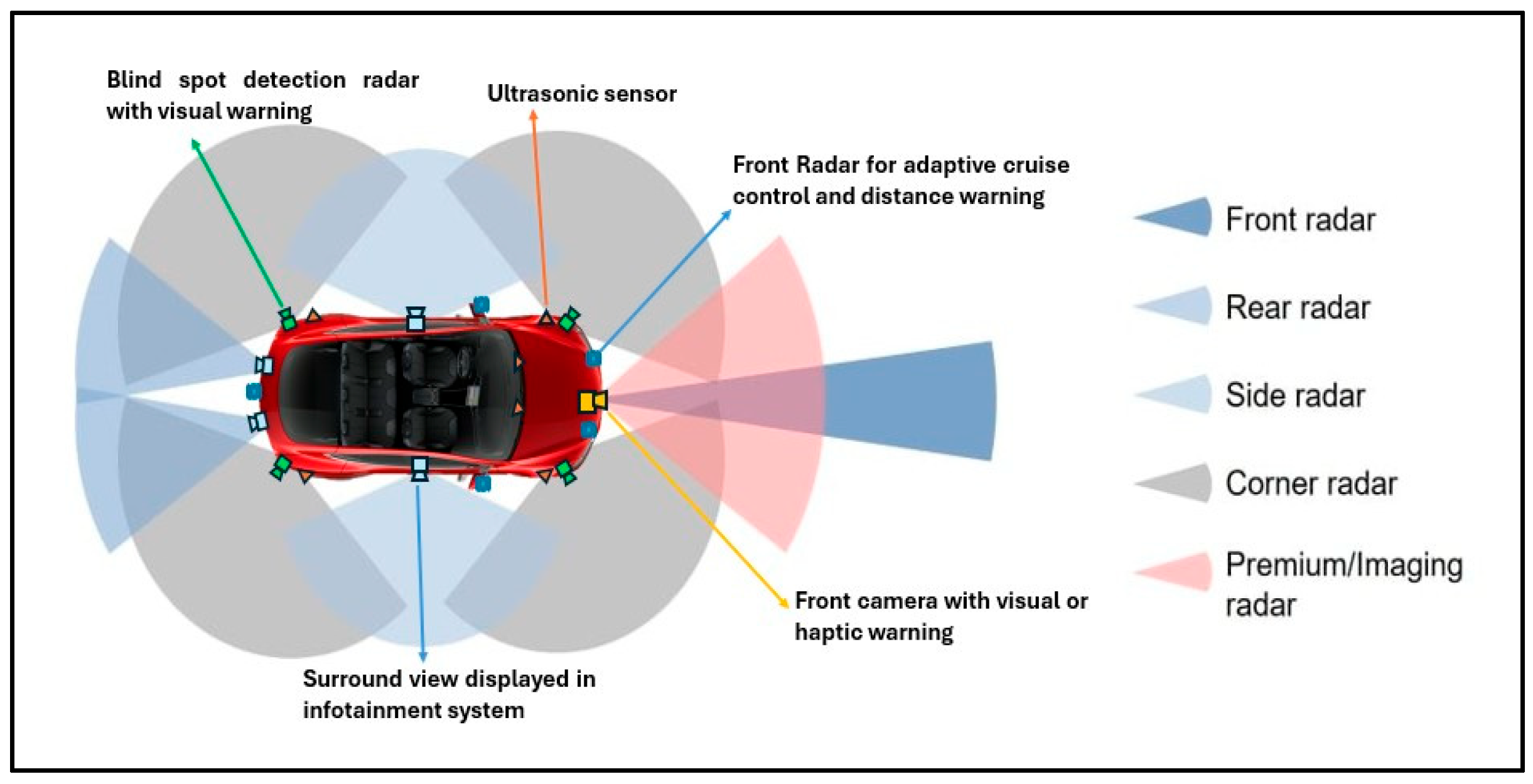

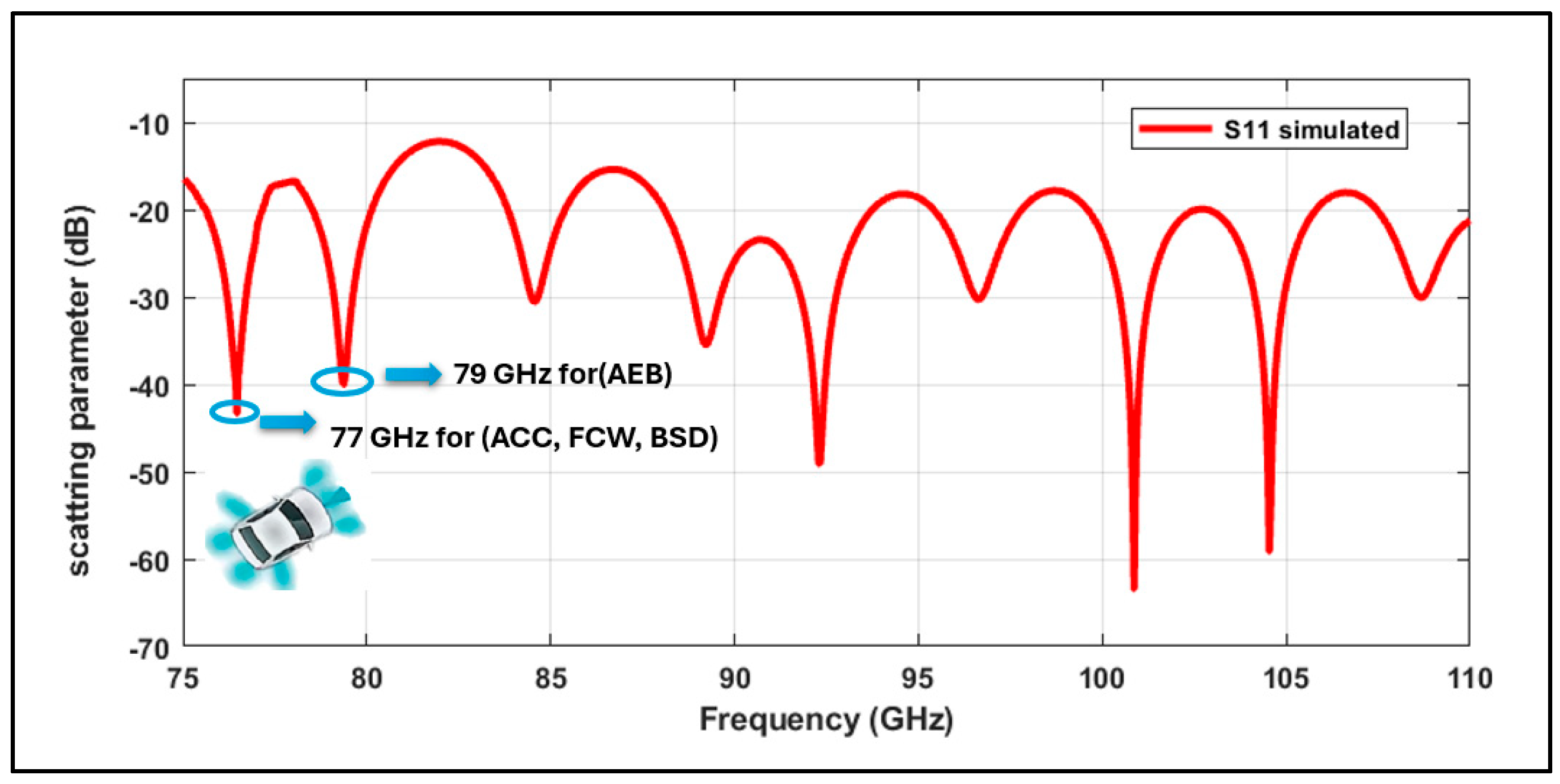


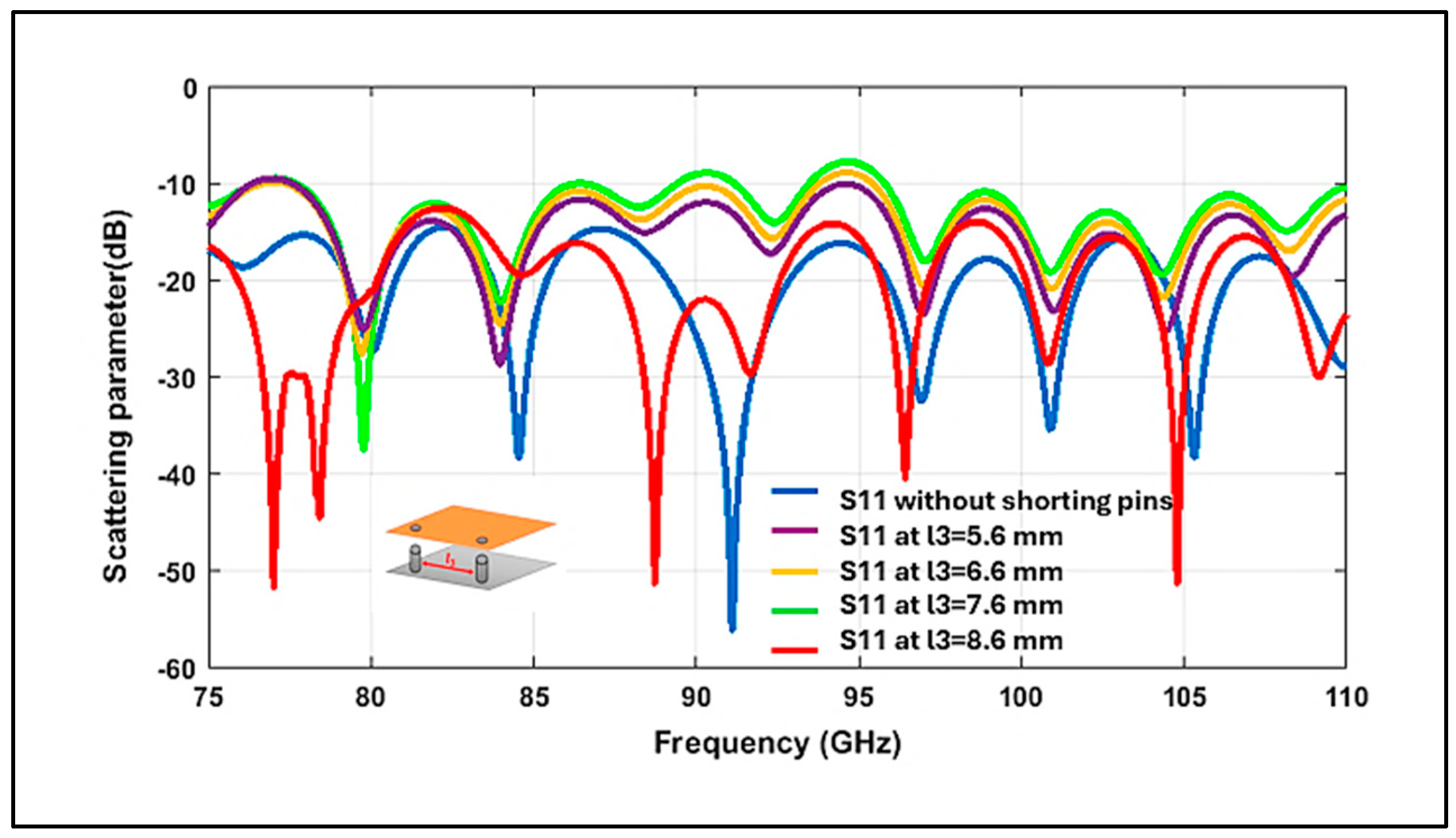
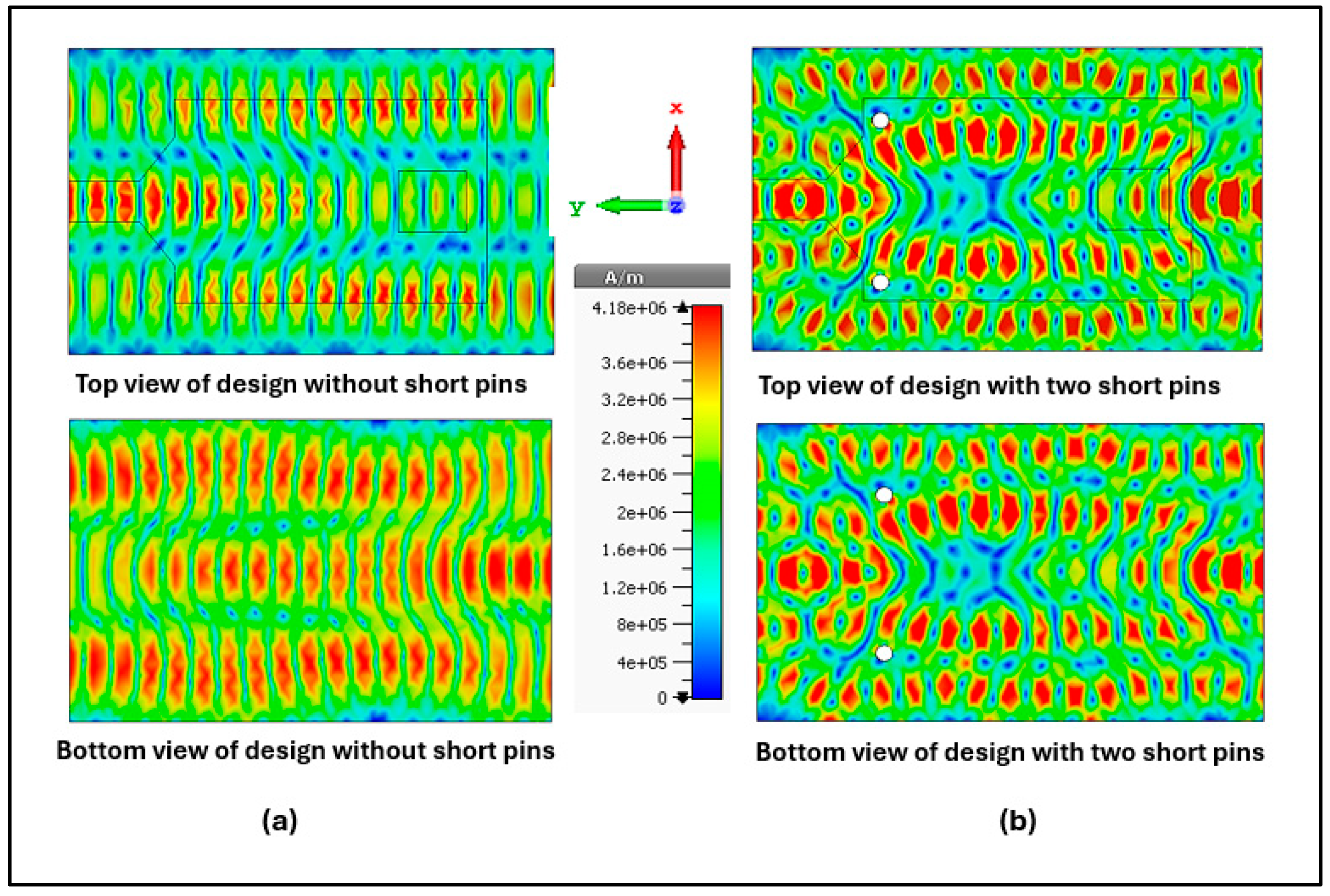





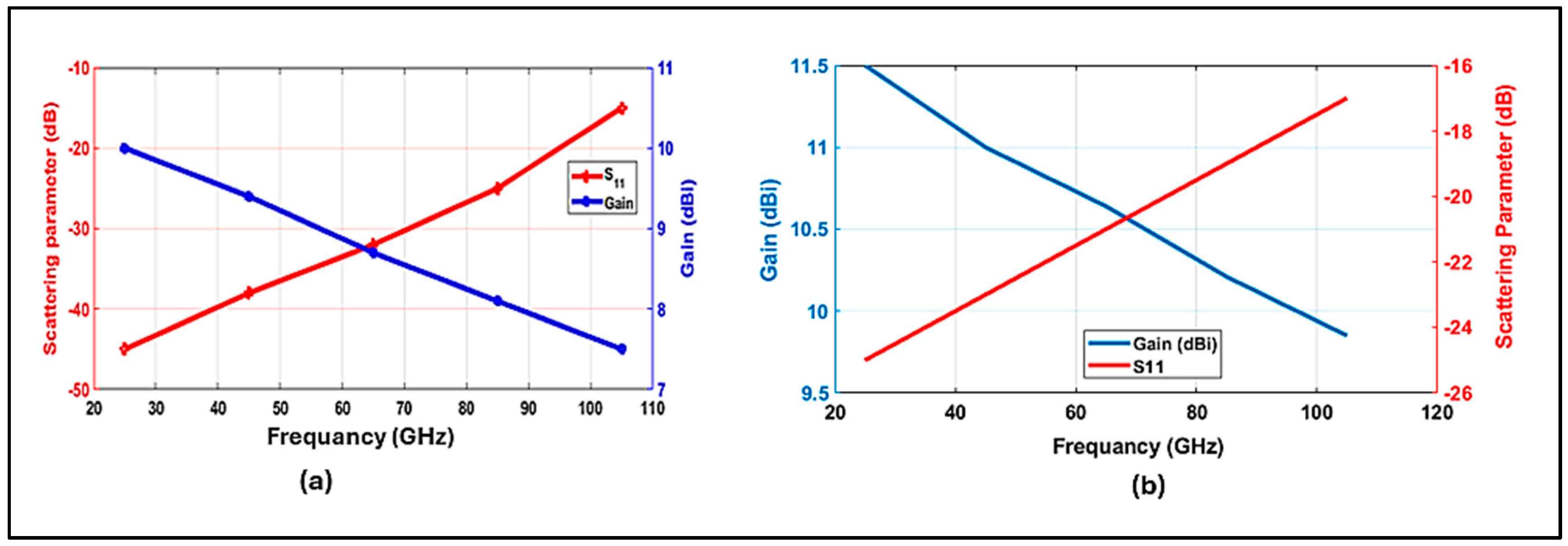
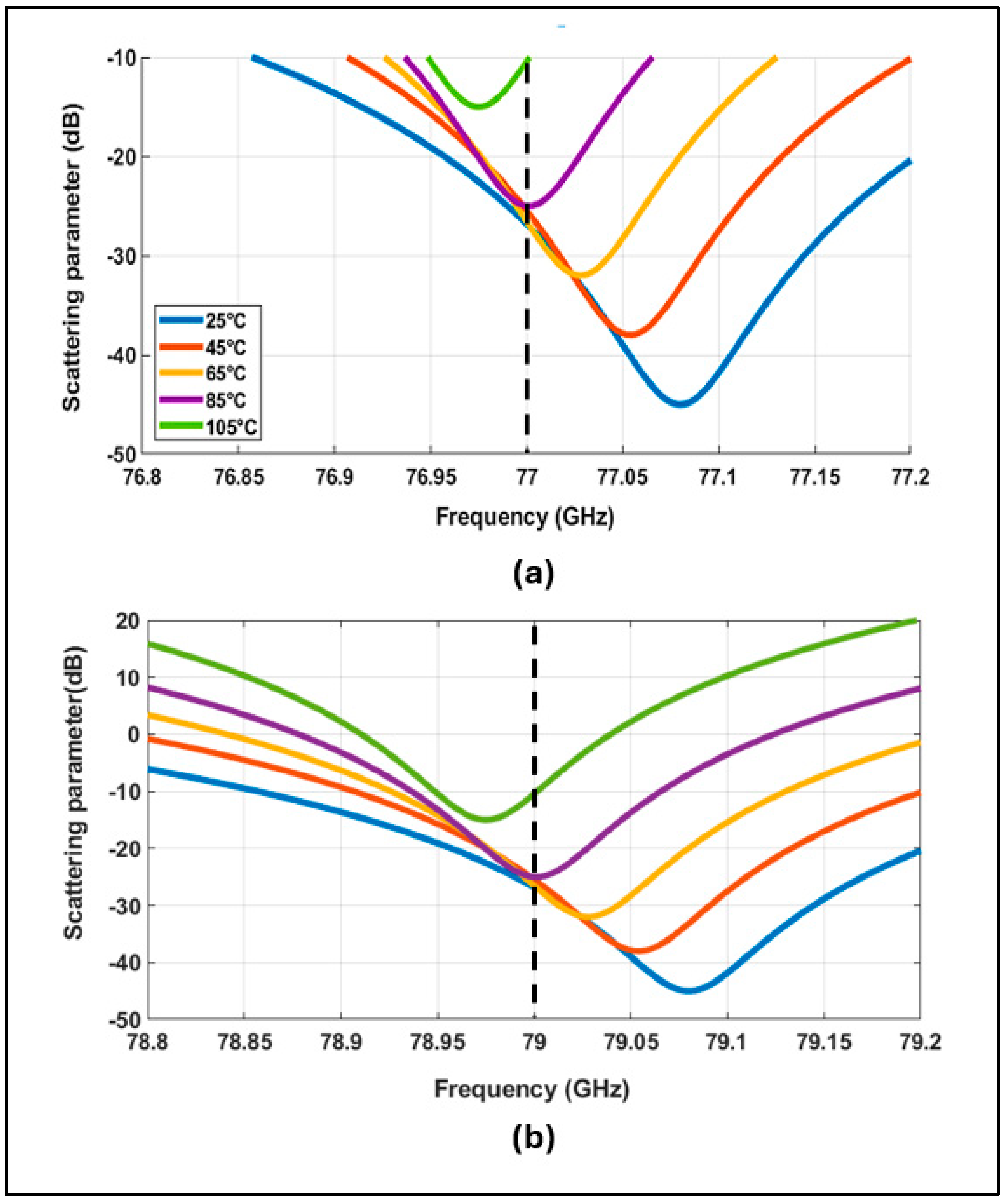

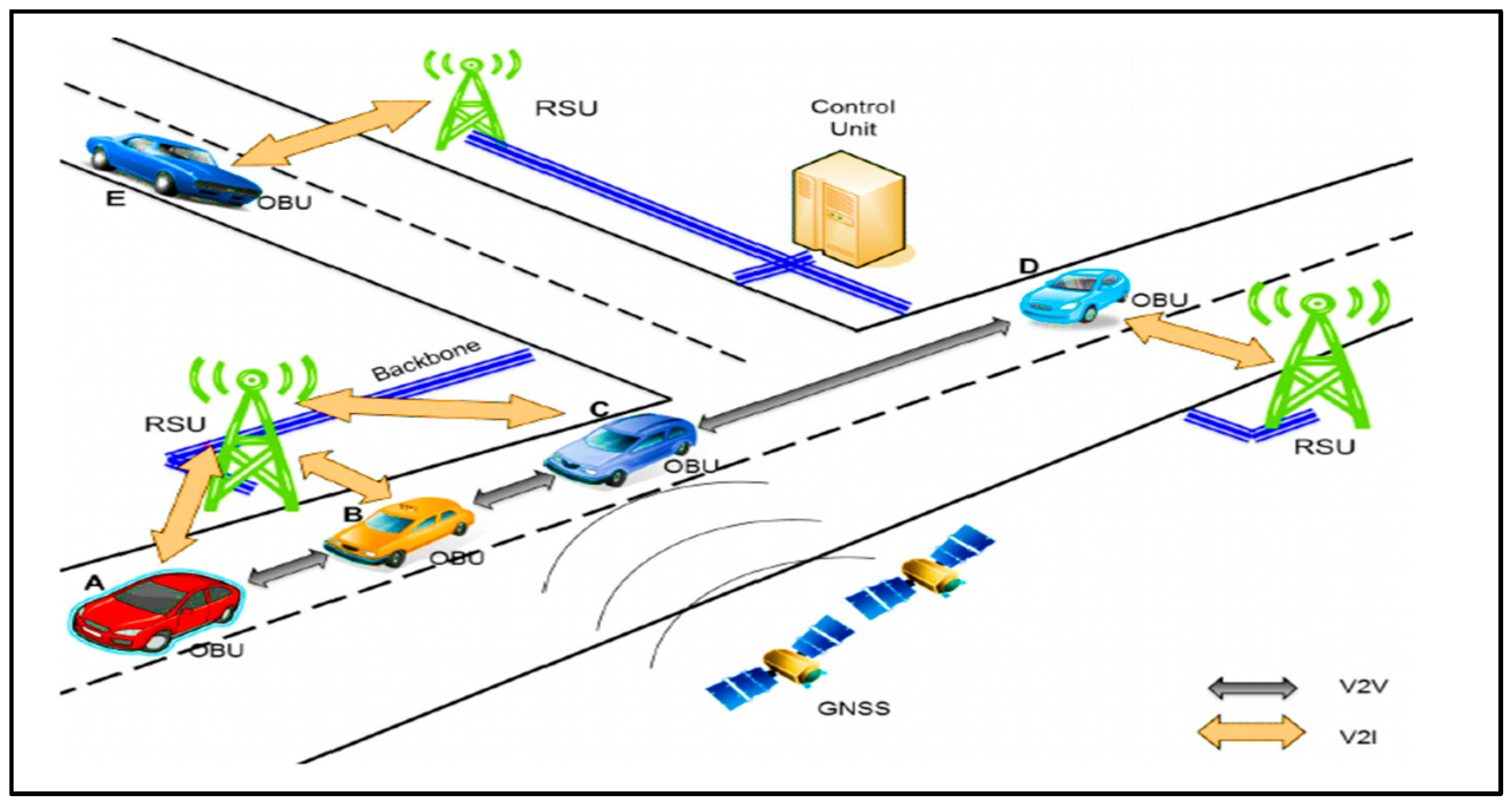
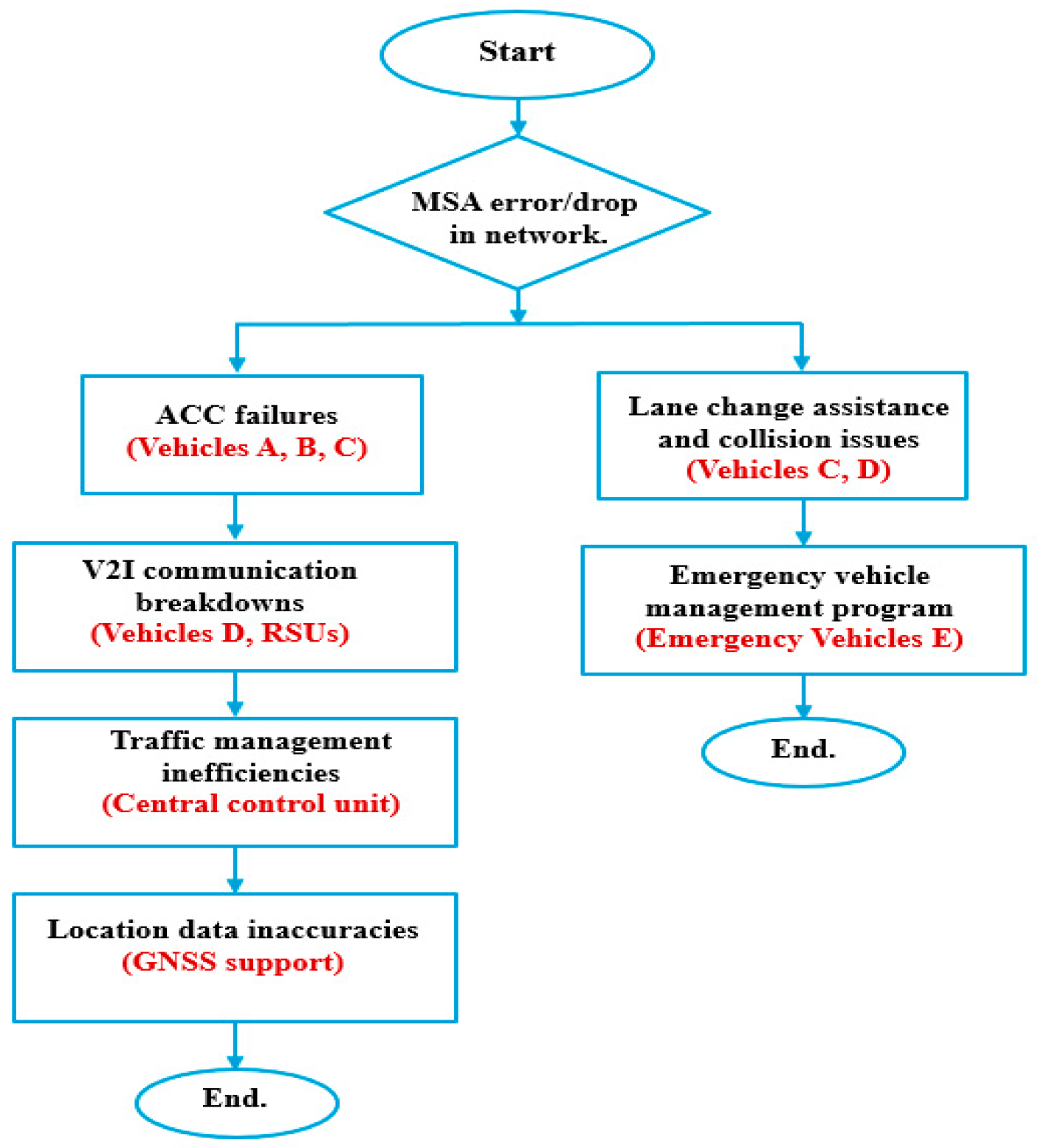
| Parameter | ADAS Target (Spec) | Achieved 77 GHz | Achieved 79 GHz |
|---|---|---|---|
| Operating band | 77–79 GHz | Met (within band) | Met (within band) |
| Input match | S11 ≤ −10 dB (VSWR ≤ 2) across band | S11 ≤ −10 dB; VSWR = 1.03; RL ≈ −36.6 dB | S11 ≤ −10 dB; VSWR = 1.12; RL ≈ −25 dB |
| Realized gain (end fire) | ≥9.5 dBi @77 GHz; ≥10.5 dBi @79 GHz | 9.9 dBi | 11.2 dBi |
| Radiation efficiency (sim.) | ≥75% over band | ≈85% | ≈79.7% |
| Main lobe pointing θmax | θmax ≤ 5° (end fire θ = 90°) | +3° (φ = 0°), +2° (φ = 90°) | +2° (φ = 0°), +1° (φ = 90°) |
| 3 dB beamwidth | 15–38° | 15.8° (φ = 0°), 13.8° (φ = 90°) | 14.6° (φ = 0°), 14.7° (φ = 90°) |
| First sidelobe level (SLL) | φ = 0° (≈≤−10 dB) θ = 90° (≈≤−10 dB) | −9.3 dB (φ = 0°), −9.1 dB (θ = 90°) | −8.5 dB (φ = 0°), −9.4 dB (θ = 90°) |
| Polarization | Linear directional | Linear directional | Linear directional |
| Ground plane | Continuous, coextensive with the substrate | Lg × Wg = 16.5 × 22 mm2 | Same |
| Footprint (board) | As compact as possible | L × W = 16.5 × 22 mm2 | — |
| Dimensions | Value (mm) | Dimensions | Value (mm) |
|---|---|---|---|
| Lsub = Lg | 16.5 | Wsub = Wg | 22 |
| l1 | 9.22 | w1 | 14.54 |
| L2 | 3.1 | w2 | 4.17 |
| L3 | 8.6 | w3 | 5.18 |
| L4 | 2 | w4 | 0.4 |
| dvia | 0.35 | W5 | 5.58 |
| Ref. | Antenna Type | Size mm2 | GHz with RL | Peak Gain (dBi) | Efficiency % | −10 dB BW (GHz; %FBW) | Fabrication |
|---|---|---|---|---|---|---|---|
| [13] | (ME-dipole) antenna array | 77 GHz, RL < −10 dBi | 12.338 | 90 | NR | PCB | |
| [15] | Patch loaded with I-shaped elements | 79 GHz RL < −10 dBi | 10.74 | NR | (operating range 77–81 reported) | PCB | |
| [14] | SIW antenna | 76.5 GHz RL < −10 dBi | 18.5 | 68.72 | NA | PCB | |
| [36] | Horn antenna | 77 GHz RL < −15 dBi | 12.2 | NR | NA | WR−12 waveguide | |
| [37] | Horn and slotted waveguide | 77 GHz, RL < −10 dBi | 17.5 | 79.4 | NA | 3D printing | |
| [38] | Wideband cavity-slotted waveguide antenna | NA | 79 GHz RL > −10 dBi | 12.36 | 62 | NA | PCB |
| [39] | Cavity-slotted waveguide, arrayable | NA | (76–81) GHz | 14.5 | NA | NA | PCB |
| The Proposed Design | SIW-tapered MSA | ) | 77, 79 GHz RL < −10 dBi | 11.5 | 85 | (2.6%) covers 77–79 | PCB |
| Temperature (°C) | 25 | 45 | 65 | 85 | 105 |
| Patch Length (mm) | 23.6 | 23.608 | 23.616 | 23.624 | 23.632 |
| Patch Width (mm) | 15 | 15.005 | 15.01 | 15.015 | 15.02 |
| Fr1 (GHz) | 77.08 | 77.054 | 77.028 | 77.001 | 76.975 |
| Fr2 (GHz) | 79.06 | 79.036 | 79.019 | 79.01 | 79.08 |
| Gain at Fr1 (dBi) | 10 | 9.4 | 8.7 | 8.1 | 7.5 |
| Gain Fr2 (dBi) | 11.5 | 11 | 10.64 | 10.21 | 9.85 |
Disclaimer/Publisher’s Note: The statements, opinions and data contained in all publications are solely those of the individual author(s) and contributor(s) and not of MDPI and/or the editor(s). MDPI and/or the editor(s) disclaim responsibility for any injury to people or property resulting from any ideas, methods, instructions or products referred to in the content. |
© 2025 by the authors. Licensee MDPI, Basel, Switzerland. This article is an open access article distributed under the terms and conditions of the Creative Commons Attribution (CC BY) license (https://creativecommons.org/licenses/by/4.0/).
Share and Cite
Abada, A.M.; El-Hameed, A.S.A.; Eldamak, A.R.; El-Hennawy, H.M. Design and Measurement of a High-Efficiency W-Band Microstrip Antenna with Enhanced Matching for 6G Automotive Radar and ADAS Systems. Technologies 2025, 13, 555. https://doi.org/10.3390/technologies13120555
Abada AM, El-Hameed ASA, Eldamak AR, El-Hennawy HM. Design and Measurement of a High-Efficiency W-Band Microstrip Antenna with Enhanced Matching for 6G Automotive Radar and ADAS Systems. Technologies. 2025; 13(12):555. https://doi.org/10.3390/technologies13120555
Chicago/Turabian StyleAbada, Alaa M., Anwer S. Abd El-Hameed, Angie R. Eldamak, and Hadia M. El-Hennawy. 2025. "Design and Measurement of a High-Efficiency W-Band Microstrip Antenna with Enhanced Matching for 6G Automotive Radar and ADAS Systems" Technologies 13, no. 12: 555. https://doi.org/10.3390/technologies13120555
APA StyleAbada, A. M., El-Hameed, A. S. A., Eldamak, A. R., & El-Hennawy, H. M. (2025). Design and Measurement of a High-Efficiency W-Band Microstrip Antenna with Enhanced Matching for 6G Automotive Radar and ADAS Systems. Technologies, 13(12), 555. https://doi.org/10.3390/technologies13120555








